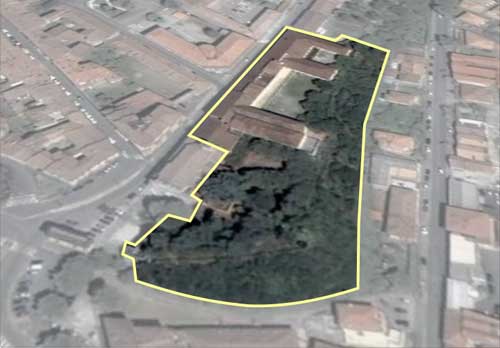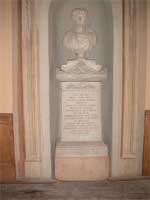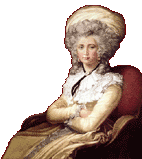The building
The Maria Cosway Foundation possesses a whole building formed by four different ones, built near one to the other, in Via Paolo Gorini, in Lodi (street nos. 2, 4 ,6 ,8, 10, 12bis; also an entrance from Piazza Zaninelli).

A part of the building is let to the Fondazione Clerici, which is a Professional Education Centre, that gives courses on primary formation, courses after-certificate, qualification courses (street no. 6), to the secondary school "Ada Negri" of Lodi's Town Concil (street no. 2) and to the Scouts (AGESCI) (entrance from Piazza Zaninelli).
On the first floor of the building, placed at street no.2, there is the Music Hall that has recently been restored with the funds of the Department of Culture; the works are on their way to being completed but at present there is still no admittance.
 In the hall there's Maria's bust, made by the sculptor Gaetano Manfredini from Milan. The placing of the work was on the 19th of July 1839 by the Town Council of Lodi. The hall, which is huge six metres by twenty, has a coved vault with stucco medallions that represent poets and musicians.
In the hall there's Maria's bust, made by the sculptor Gaetano Manfredini from Milan. The placing of the work was on the 19th of July 1839 by the Town Council of Lodi. The hall, which is huge six metres by twenty, has a coved vault with stucco medallions that represent poets and musicians.
The hall has been converted different times:
- it has been a dormitory for pilgrims when it was still the monastry of the Minimi Friars;
- it was directly connected to the lower sacristy;
- entertaining hall, since it became a college;
- restored in 1825, the pannelled ceiling is replaced by a depressed barrel vault;
- finally, in 1855 the hall was restored again by Eng. Carlo Moroni and decorated (probably) by Pietro Ferrabini.
On the last floor of the building, placed at street no.10, is located the nuns' Chapel which isn't open to the public as it is waiting to be restored to become in the future a museum. The chapel, built between 1855 and 1859, shows the decorative painting by Pietro Ferrabini, the stuccoing by Architect Giovanni Bleni and the altar by the Giudici brothers.
History of the building
The site was occupied in 1669 by the friars of San Francesco di Paola, named Paolotti (they had already been in that area since 1657), who built the monastry and the church which was consacrated in 1674. The last works to complete the architectural structure and the religious ornaments of the church, took place during the XVIII century where, in 1743, the first cloister was completed.
The outside part of the church was then completed after the second world war. The facade, left unfinished, in 1954 has been completed in a neobaroque style that we can admire in the façade of San Filippo. In the inside, there is a greek cross nave that has two chapels on each side and it extends to a semicircular and deep choir. At one third of the height of the apse wall there is a balcony with a wrought iron railing from which we can reach the central niche: here is preserved a XV century fresco with the miraculous image of the Owner. In the inside there are baroque frescos, plenty of squared decorations, rocailles, flower motifs. From the right platform we can reach the funeral chapel of Baroness Maria Cosway, in neoclassical style.
The building stages of the monastry and their continual succession in time are really uncertain and the complex in it's whole never offered a specific monument or artistic interest.
The dismantling of the Minimi headquarters occurred with the last Napoleonic suppressions and has gone on in several stages since 1775. A census of the monastry library was taken, the library itself was closed and its keys given on the 12th of April 1798 to the superintendents in charge.
The monastry official suppression occurred on the 11th of May 1810 and the monastry building was first transferred to Carlo Giuseppe Gariboldi, who proceeded in place of Luigi Picaluga (Picaluga, from his side, had bought it on the 11th of November 1811 from the Management State Property Office in the Department of Olona and Uniti, on behalf of the Administration Fund); in the second place, it was then transferred to Earl Francesco Melzi d'Eril, who bought it (29th of Febraury 1812) for Maria Cosway.
Maria, in a letter dating 31st of December 1811 and addressed to Melzi d’Eril, writes: “the owner of the monastry of the Grazie has offered it to me on sale and I went to look at it. It is near the town gate (Cremona), on a delicious site, nice view of the countryside... and the house is nice and comfortable. Beautiful staircase, refectory, rooms, and pulling down some of the walls we can make good dormitories. There's a lovely garden and court. All in all this I think it's really worthwhile to me”.
At the beginning, Maria proceeded by arranging first af all the use at present of the old building structures; then followed the purchase of several real estates (from 1822 to 1833) in the nighbourhood of the College. Already on the 4th of May 1812 the Town Council decided itself for "the free transfer of that part of the bastion... giving it completely in total usage to the College, untill this will exist, with the proviso that the soil of the plot transferred will not be touched, so, as not to endanger the firmness of the public walls".
A map that shows us the area between the boundary of the monastry garden, now the College, and the bastion, is preserved in the historical archives of Lodi's Town Council; it shows us how the property was subdivided in 1812. There is a note, signed by Maria Cosway, declaring that she had received a copy of the document.
Some works were done to widen and improve the building perspectives looking onto the street (now, Via Paolo Gorini) and the general outer aspect of the Institute, as the will expressed by the Founder.
A year later after the death of the Founder (occurred in 1838), a new building on the east side was raised, so as to form a courtyard with a "U" shape: this part would then become the noble court of the building. Finally, the project of 1855 gave the definitive physiognomy to the College, which we can still admire today.
The English Ladies (30th of April 1915) put some rooms at the disposal the Red Cross Subcommittee of Lodi (founded in 1887 by Paolo Gelmini), who was deciding to create a hospital, in the event of – more and more likely to happen – Italy entering the war.
![]()
Fondazione Maria Cosway Via Paolo Gorini, 6 26900 Lodi C.F. 84511920153

